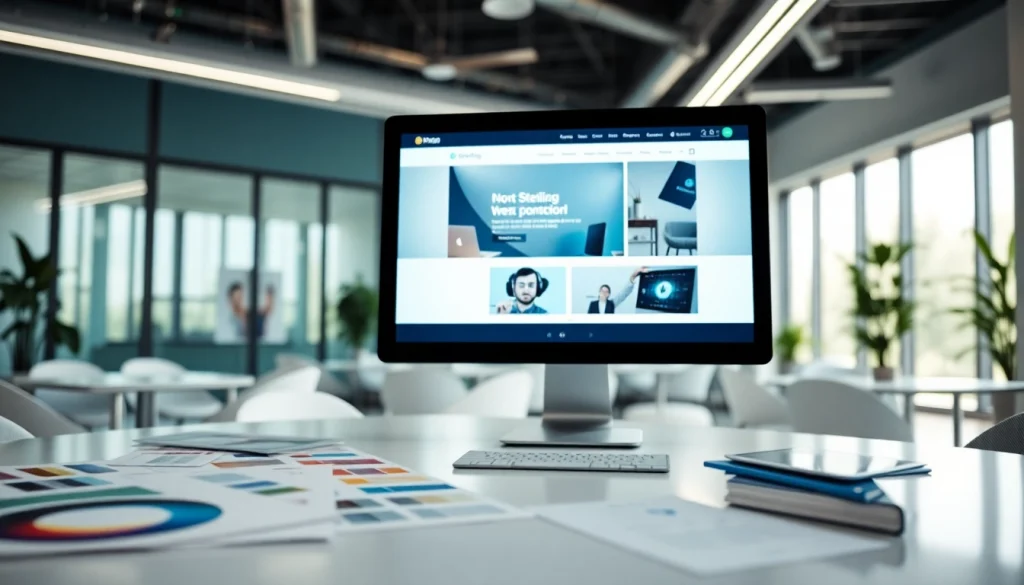Mastering Website Design: Principles and Techniques for Creative Success

Understanding Website Design Fundamentals
In today’s digital landscape, the significance of website design cannot be overstated. It serves as the face of a business and plays a crucial role in shaping user perceptions and experiences. To harness the potential of website design effectively, it is essential to grasp its core principles, components, and the integral role it plays in user experience. In this guide, we will delve into the fundamentals of website design, exploring the key principles and components that contribute to building engaging, effective, and aesthetically pleasing websites.
Key Principles of Website Design
At the heart of any successful website lies a set of design principles that guide its development. Here are some essential principles to consider:
- Clarity: A clear design communicates the website’s purpose and message effectively, ensuring users understand what to expect.
- Consistency: Consistent layouts, colors, and typography throughout the website help create a cohesive brand identity and enhance usability.
- Hierarchy: Visual hierarchy helps guide users’ attention by emphasizing the most important elements, making navigation more intuitive.
- Balance: A well-balanced layout ensures that the page content doesn’t feel cluttered or overwhelming, contributing to a pleasant viewing experience.
- Accessibility: Designing for accessibility ensures that all users, including those with disabilities, can navigate and interact with the website.
Core Components of Effective Web Design
The components of website design can be divided into various categories, each playing a vital role in the overall experience:
- Layout: The layout determines the visual structure of a website, including grid systems, whitespace, and the arrangement of elements.
- Color Scheme: Colors evoke emotions and set the tone of the site. Choosing the right color palette can enhance the user experience and reinforce brand identity.
- Typography: The choice of fonts and how they are used on the site affects readability and aesthetics. Well-selected typography can enhance comprehension and user engagement.
- Images and Graphics: Visual content can significantly enhance a website’s appeal. High-quality images and graphics contribute to professional-looking designs.
- Buttons and Calls to Action (CTAs): Clear and compelling CTAs encourage user interaction and drive conversions.
The Importance of User Experience in Website Design
User experience (UX) focuses on the overall satisfaction users derive from interacting with a website. Here are some key aspects of UX in web design:
- Usability: Websites should be easy to navigate, enabling users to find information quickly and efficiently.
- Speed: Fast-loading pages improve user satisfaction and reduce bounce rates.
- Responsive Design: Websites must be optimized for all devices, including desktops, tablets, and smartphones, ensuring a seamless experience.
- Feedback Mechanisms: Offering users feedback—like visual cues on button clicks or form submissions—can improve their interaction with the site.
- Emotional Connection: Designing with empathy in mind can create emotional connections between users and the brand, enhancing loyalty.
Choosing the Right Tools for Website Design
Utilizing the right tools can streamline the website design process and enhance the final product. Here, we explore various software solutions, the differences between free and paid options, and essential features to consider.
Software Solutions for Creating Stunning Websites
There are a myriad of software tools available for website design, each with its own strengths and weaknesses. Some popular categories include:
- Content Management Systems (CMS): Platforms like WordPress or Joomla provide tools to create, manage, and modify content without needing extensive coding knowledge.
- Website Builders: User-friendly website builders like drag-and-drop tools enable users to create websites with minimal technical skills.
- Graphic Design Software: Tools such as Adobe Photoshop or Sketch are essential for creating custom graphics and visuals.
- Prototyping Tools: Software like Figma or Adobe XD allows designers to create prototypes for user testing and feedback.
Comparing Free vs. Paid Tools for Website Design
When it comes to website design tools, users often face the choice between free and paid options. Both have their pros and cons:
- Free Tools: Ideal for beginners or those with minimal budgets, free tools can still provide basic functions. However, they may come with limitations such as watermarked designs, limited storage, or lack of support.
- Paid Tools: Paid tools often offer advanced features, excellent customer support, and a more extensive range of capabilities, which can be vital for professional-grade website design. Nonetheless, they require a financial investment.
Essential Features to Look for in Design Tools
Regardless of whether you choose free or paid tools, there are essential features to prioritize:
- Customization Options: Ability to modify layouts, colors, and typography to match brand identity.
- Responsive Design Capabilities: Tools should allow for seamless viewing across various devices.
- SEO Features: Built-in tools that facilitate search engine optimization practices.
- Collaboration Features: Support for teamwork, enabling multiple users to work on projects simultaneously.
- Analytics Integration: Ability to track metrics and user behavior, contributing to informed design decisions.
Crafting an Engaging Website Design
Creating a visually appealing and functional website involves understanding several critical aspects of design. This section discusses color theory, typography, effective layouts, navigation, and the integration of interactive elements.
Color Theory and Typography in Web Design
Color and typography are two foundational elements that significantly influence a user’s perception:
- Color Theory: Understanding the psychology of colors helps in selecting palettes that resonate with audiences. For instance, blue often conveys trust, while red can invoke urgency.
- Typography Choices: Different fonts evoke varying feelings; legible fonts improve readability, while unique fonts can enhance brand identity.
When paired effectively, color and typography can enhance visual appeal and guide users’ emotions and interactions.
Creating Effective Layouts and Navigation
The organization of content is fundamental to a website’s usability. Some key strategies include:
- Grid Systems: Utilizing grids allows for structured layouts, providing a balanced and aligned appearance.
- Intuitive Navigation: Menus should be clearly labeled and easily accessible to enhance user experience and facilitate information discovery.
- Whitespace: Effective use of whitespace can prevent clutter, allowing elements to breathe and making the overall layout more digestible.
Integrating Interactive Elements into Website Design
Interactivity is a powerful component that engages users. Consider incorporating:
- Hover Effects: Visual changes when users hover over elements can guide actions and enhance user interaction.
- Animations: Animated transitions can create a dynamic feel, but should be used judiciously to avoid distracting users.
- Forms and Surveys: Interactive forms enable user feedback and data collection, which can drive improvements.
Best Practices for Responsive Website Design
Responsive design ensures that websites function seamlessly across various devices and screen sizes. Various approaches can contribute to effective responsive website design.
Ensuring Mobile Optimization in Your Design
With mobile traffic on the rise, mobile optimization is paramount:
- Flexible Grids: Use fluid grids that adjust to screen size, ensuring layout consistency.
- Viewport Configuration: Proper viewport settings in the code optimize the display for mobile devices.
- Responsive Images: Images should scale according to screen resolutions, ensuring quality across devices.
Techniques for Testing Your Website Design
Testing is vital to confirm the effectiveness of design across devices:
- Device Testing: Testing on various devices helps identify issues with layout, usability, and functionality.
- Browser Compatibility: Ensuring consistent performance across different web browsers enhances accessibility for all users.
- User Testing: Conducting testing with real users can provide insights into their experience, guiding necessary revisions.
Maintaining Design Consistency Across Devices
Consistency in design helps reinforce user familiarity:
- Use of Foundation Styles: Implement a common design framework to maintain consistent styles and layouts.
- Unified Branding: Ensure that brand elements, including logos and color schemes, are consistent across all platforms.
- Clear Content Strategy: Maintain consistent messaging and tonality across all devices to reinforce the brand identity.
Measuring Success in Website Design
Measuring the success of website design involves analyzing various performance metrics and user feedback. This section outlines key performance indicators (KPIs) and methods for continuous improvement.
Key Performance Indicators for Web Design Efficiency
To evaluate the effectiveness of a website’s design, certain KPIs should be monitored:
- Bounce Rate: A high bounce rate may indicate issues with design or content that do not meet user expectations.
- Average Session Duration: This metric reveals how long users engage with the website, signaling content relevance and interest.
- Conversion Rate: Tracking how well the website drives actions such as signups or purchases helps determine its success.
- Page Load Speed: Analyzing the speed at which pages load affects user satisfaction and engagement levels.
Analyzing User Feedback and Behavior
Understanding user interactions and feedback is crucial for refining design:
- Surveys and Polls: Collecting users’ opinions can provide direct insight into user satisfaction and areas for improvement.
- Heatmaps: Utilizing heatmap tools to track where users click can help identify popular content and optimize layout.
- User Sessions Recordings: Analyzing video recordings of user sessions may reveal usability issues that need addressing.
Continual Improvement: Adapting Your Design Strategy
The digital landscape is ever-evolving, necessitating ongoing improvements:
- Regular Content Updates: Refreshing content keeps the website relevant and engaging, encouraging repeated visits.
- Staying Current with Design Trends: Keeping abreast of the latest design trends can prevent the site from appearing outdated.
- Iterative Design Process: Employing an iterative approach allows for gradual refinements based on user feedback and performance metrics.
By systematically understanding the principles of website design, utilizing the right tools, fostering engaging designs, ensuring responsiveness, and measuring success, any business can enhance its online presence. This journey requires commitment and adaptability, but the rewards of an effective website design will resonate with users and lead to sustained success.







